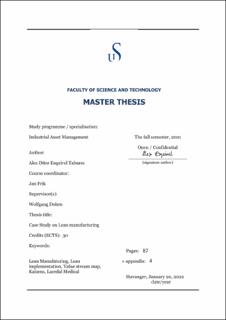| dc.description.abstract | Technological companies are struggling to keep competing in the global market. Customers have higher expectations now that an efficient and high-quality product is no longer sufficient. For example, Laerdal has to offer configurable solutions on their manikins to meet individual customer needs. All this at a reasonable lead time and cost. Lean manufacturing has proven to be a successful tool to attain a competitive advantage by streamlining the production process from raw material to the customer.
This master thesis presents a case study on Lean Manufacturing developed at Laerdal’s Stavanger manufacturing plant. The objective was to map the value stream of a manufacturing process and identify “7 types of waste”. This mapping found that work order process and production planning were areas of opportunity for continuous improvement, which followed two hypotheses. One of them said that the work order process method could be more efficient and help eliminate waste of time. The other says that production planning is cumbersome and can be improved by limiting trigger points and streamlining the current production process.
The results supported hypothesis one by demonstrating how lean manufacturing can help the work order method to be more efficient by eliminating non-value activities found and reducing the cycle time by 50 % on average of the work order cycle, plus “waiting time,” which 53% took days, 20% took hours and 27% took minutes. Also, a non-value add activity was eliminated, which took 6 minutes per cycle.
The results support hypothesis two by demonstrating how the production planning could increase the efficiency and eliminate waste of time in production planning by introducing a pull system (Kanban) for most of the roto-molding parts, streamlining the process, and limiting trigger points by one.
The method used was action-based research, where you will find experimentation and data collection in multiple cycles. Data in the form of photos, surveys, interviews, achievement data, and documents provided by Laerdal; Then, connected with a literature study on Lean manufacturing theory and Lean manufacturing in a project setting area. | |
